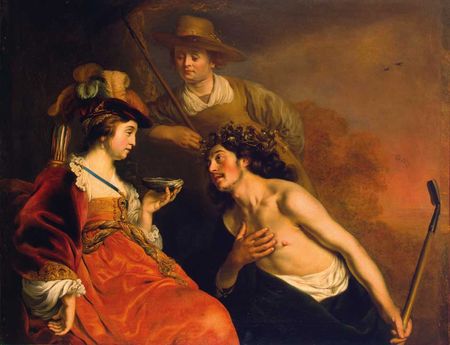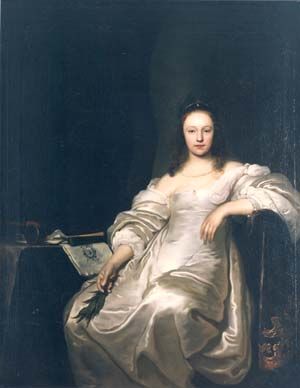"Jacob Backer (1608/9-1651). Rembrandt's Opposite" @ Museum Het Rembrandthuis
Jacob Backer, Granida and Daifilo, ca. 1637, Oil on canvas, © The State Hermitage Museum, St. Petersburg, 2008
AMSTERDAM.- Museum Het Rembrandthuis presents Jacob Backer (1608/9-1651). Rembrandt’s Opposite, on view through February 22, 2009. The Amsterdam artist Jacob Adriaensz. Backer (1608/9-1651) was one of the most successful painters of the Golden Age. Four hundred years after his birth he is now being honoured with a major retrospective of his finest works. The exhibition makes clear why this virtuoso painter was so highly regarded by his contemporaries: his vivid use of colour and accurate touch gave his paintings an unprecedented allure.
In Rembrandt’s Shadow - Jacob Backer was a contemporary of Rembrandt and one of Amsterdam’s most eminent artists in the 1640s. He was renowned among his contemporaries because of his exquisite portraits and his brilliant painting technique. Yet Backer is as unknown now as he was famous in his own time. Since the nineteenth century attention has been primarily focused on Rembrandt, and as a result many of his contemporaries have been forgotten. For a long time Backer was thought—incorrectly—to have been a pupil of Rembrandt’s and this obscured the view of Backer’s role as an eminent and innovative artist whose style developed very differently from his.
Apprenticeship - We do not know who gave Backer his first painting lessons. What is certain is that from 1626 he worked in Lambert Jacobsz ‘s studio in Leeuwarden. Around 1632 Backer moved to Amsterdam, where he may have worked for the art dealer Hendrick Uylenburgh, as Rembrandt had a few years before. Backer rapidly developed into one of Amsterdam’s most fashionable painters.
‘Outstanding’ painter in Amsterdam - Backer was praised by his contemporaries as an excellent history painter and a gifted portraitist. He is regarded as the pioneer of Amsterdam classicism because of his vivid use of colour and his evenly balanced, often very large compositions. The swift, assured brushstrokes and an incredible feeling for plasticity gave his history pieces an impressive directness. His expertly painted portraits of the Amsterdam elite were universally acclaimed. Backer built up a sizeable oeuvre at a staggeringly high speed. No fewer than one hundred and forty paintings can now be attributed to him: a huge number for an artist who was active for no more than twenty years.
Rembrandt’s Opposite - In many respects Jacob Backer can be regarded as Rembrandt’s opposite; as a painter, as a draughtsman and as a man. Although at first sight Backer’s early work seems akin to Rembrandt’s manner of painting from the early 1630s, he went in the opposite direction. Whereas Rembrandt painted more and more expressively, with strong chiaroscuro and an emphatic realism, Backer excelled as a colourist, with vivid and elegant compositions. Even as draughtsmen the two artists were poles apart. In search of the most convincing way to tell a story Rembrandt often made sketches of several figures expressing different feelings. Backer, on the other hand, usually concentrated on one figure, which is often stylized or idealized, and where an emotion can seldom be recognized. What’s more Backer usually drew his figures in black and white chalk on blue paper, a technique that Rembrandt never employed. Backer’s impeccable reputation likewise contrasts strongly with Rembrandt’s. Rembrandt’s debts, the many court cases brought against him and which he pursued against others, are well known. But from the little information that we have about Backer, he comes across as a gentleman, whose name was regarded with respect by everyone; a painter who never married, bought a house or featured in sordid court cases.
Masterpieces from Backer’s oeuvre have been selected for the exhibition. The forty or so paintings and twenty drawings come from leading museums in the Netherlands and abroad and from private collections. Some of the works are being exhibited for the first time.
A lavishly illustrated catalogue by Peter van den Brink et al., Jacob Backer (1608/9-1651), Waanders Publishers, Zwolle 2008, is being published to accompany the exhibition. Price € 39.95 (paperback), € 47.95 (hardback).
Jacob Backer, Portrait of a woman as the Muse Euterpe, ca. 1649/50, Albert Vandervelden, Luik
Jacob Backer, Shepherd with a wreath and a flute, ca. 1644, Koninklijk Kabinet van Schilderijen Mauritshuis, The Hague

/https%3A%2F%2Fprofilepics.canalblog.com%2Fprofilepics%2F1%2F0%2F100183.jpg)
/https%3A%2F%2Fstorage.canalblog.com%2F03%2F02%2F119589%2F96711876_o.jpg)
/https%3A%2F%2Fstorage.canalblog.com%2F11%2F31%2F119589%2F94773502_o.jpg)
/https%3A%2F%2Fstorage.canalblog.com%2F20%2F83%2F119589%2F94772815_o.jpg)
/https%3A%2F%2Fstorage.canalblog.com%2F26%2F72%2F119589%2F75604929_o.jpg)
/https%3A%2F%2Fstorage.canalblog.com%2F59%2F60%2F119589%2F26458628_o.jpg)





/http%3A%2F%2Fstorage.canalblog.com%2F84%2F73%2F119589%2F128782095_o.jpeg)
/http%3A%2F%2Fstorage.canalblog.com%2F46%2F22%2F119589%2F122366228_o.jpg)
/http%3A%2F%2Fstorage.canalblog.com%2F56%2F77%2F119589%2F117688917_o.jpg)
/http%3A%2F%2Fstorage.canalblog.com%2F19%2F40%2F119589%2F112043921_o.jpg)